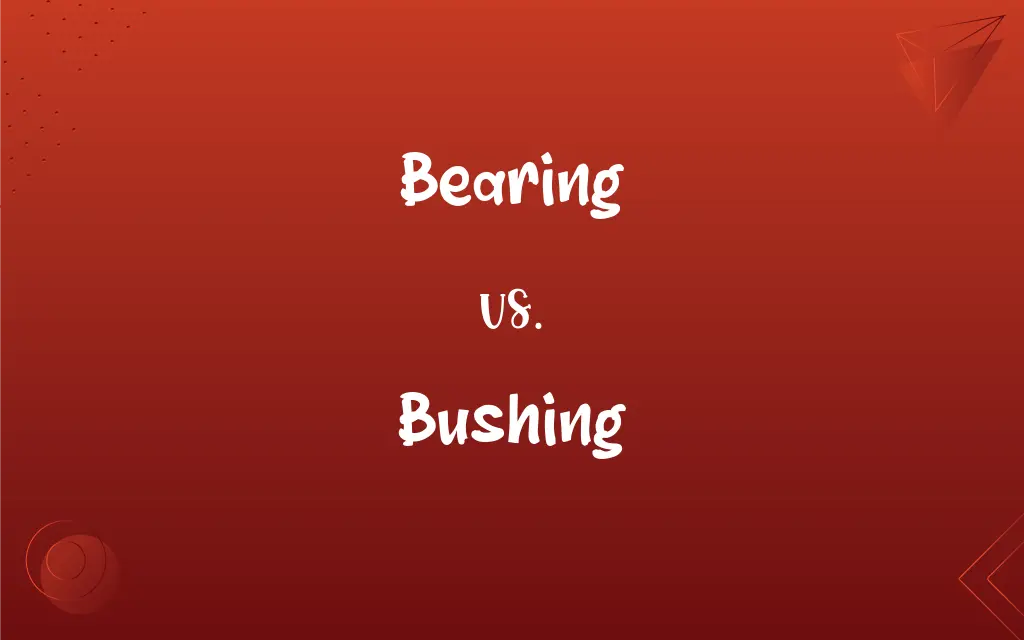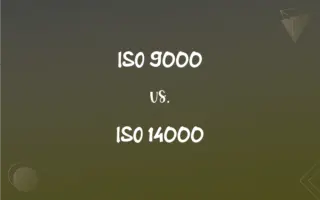Bearing vs. Bushing: What's the Difference?
Edited by Aimie Carlson || By Harlon Moss || Published on March 2, 2024
A bearing is a machine element that constrains relative motion and reduces friction, while a bushing is a type of bearing that is a removable cylindrical lining.

Key Differences
Bearings are machine elements designed to constrain relative motion and minimize friction between moving parts, often using balls or rollers. Bushings, a type of plain bearing, are cylindrical linings that provide a smooth surface for sliding motion between parts.
Bearings are made from various materials including steel, ceramic, and plastic, and can be complex assemblies. Bushings are typically simpler, made from materials like bronze, plastic, or rubber.
Bearings are used for both rotary and linear motion, depending on their design (ball, roller, etc.). Bushings are primarily used for sliding or pivoting motion, where a rotating shaft or hinge is involved.
Bearings are designed to handle high load and speed applications with minimal wear and tear. Bushings, while capable of handling loads, are better suited for lower speed applications.
Bearings are used in a wide range of applications from small machinery to large industrial equipment. Bushings are commonly used in automotive suspension systems, hinges, and other pivoting assemblies.
ADVERTISEMENT
Comparison Chart
Function
Constrains motion, reduces friction
Provides a smooth lining for sliding parts
Materials
Steel, ceramic, plastic
Bronze, plastic, rubber
Motion Type
Rotary and linear
Sliding and pivoting
Load and Speed
High load and speed
Lower speed, moderate load
Common Applications
Machinery, industrial equipment
Automotive suspension, hinges
ADVERTISEMENT
Bearing and Bushing Definitions
Bearing
A machine element that facilitates motion and reduces friction.
The mechanic replaced the worn bearings in the engine.
Bushing
A removable lining for a bearing that provides a bearing surface.
The bushing in the car's suspension system was replaced to stop the squeaking.
Bearing
An element used in machinery to allow smooth rotational or linear movement.
The wind turbine's functionality depends heavily on its bearings.
Bushing
A cylindrical sleeve used in machinery to reduce wear.
Bushings in the door hinge prevent metal-on-metal contact.
Bearing
A component that helps to bear the load and reduce wear in machines.
Regular maintenance of bearings is crucial for industrial machinery.
Bushing
An insert that provides a bearing surface for rotary applications.
The mechanic used a bushing to fix the wobbly fan blade.
Bearing
A mechanical support used to reduce the friction between moving parts.
The bicycle’s smooth ride was attributed to its high-quality bearings.
Bushing
A type of plain bearing designed to reduce friction and wear.
The machine's efficiency improved after installing new bushings.
Bearing
A device that supports, guides, and reduces the friction of motion.
Bearings are essential for the smooth operation of skateboards.
Bushing
A component used to support a pivot or shaft in machinery.
Replacing worn bushings can significantly reduce operational noise.
Bearing
The manner in which one carries or conducts oneself
The poise and bearing of a champion.
Bushing
A fixed or removable cylindrical metal lining used to constrain, guide, or reduce friction.
Bearing
A machine or structural part that supports another part.
Bushing
(Electricity) An insulating lining for an aperture through which a conductor passes.
FAQs
Do bearings require lubrication?
Yes, most bearings require lubrication to function effectively.
What is the primary purpose of a bearing?
To reduce friction and facilitate smooth motion in machinery.
Are bushings and bearings interchangeable?
Not always, as they serve different specific functions.
What materials are bushings typically made of?
Commonly bronze, rubber, or plastic.
Can bushings handle heavy loads?
Yes, but they are more suited for moderate loads.
How often should bearings be replaced?
It depends on usage, but regular inspection and maintenance are important.
Can bearings reduce both radial and axial loads?
Yes, depending on the type of bearing.
Are there different types of bearings?
Yes, including ball, roller, and needle bearings.
What causes bearing failure?
Common causes include improper installation, lack of lubrication, and overloading.
What is a key advantage of bushings?
They provide a low-cost, effective solution for reducing wear and friction.
Do bushings need maintenance?
Yes, regular inspection and lubrication are important.
How do bushings affect machine noise?
Properly functioning bushings can reduce operational noise.
Are bearings used in automotive applications?
Yes, in many parts like wheels, transmissions, and engines.
Can bushings be self-lubricating?
Yes, some bushings are designed to be self-lubricating.
How do I know if a bearing needs replacement?
Signs include unusual noise, decreased motion efficiency, and visible wear.
What's the difference between a ball and roller bearing?
Ball bearings use spherical balls, while roller bearings use cylindrical rollers.
How do temperature changes affect bushings?
Extreme temperatures can cause expansion or contraction, affecting performance.
Are sealed bearings maintenance-free?
They require less maintenance but are not entirely maintenance-free.
Can I replace a bushing myself?
Yes, if you have the right tools and knowledge.
Can bushings be used in high-speed applications?
They are generally better for lower speed applications.
About Author
Written by
Harlon MossHarlon is a seasoned quality moderator and accomplished content writer for Difference Wiki. An alumnus of the prestigious University of California, he earned his degree in Computer Science. Leveraging his academic background, Harlon brings a meticulous and informed perspective to his work, ensuring content accuracy and excellence.
Edited by
Aimie CarlsonAimie Carlson, holding a master's degree in English literature, is a fervent English language enthusiast. She lends her writing talents to Difference Wiki, a prominent website that specializes in comparisons, offering readers insightful analyses that both captivate and inform.
































































